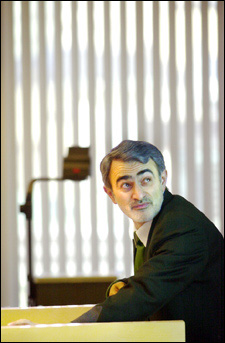Iranian primary care produces big results:
Revamped health system sees life expectancy up, fertility down

The Iranian health-care system, which places a heavy emphasis on primary care, has dramatically increased life expectancy and lowered population growth since 1986, according to the vice chancellor of Tehran University of Medical Sciences.
In a talk to the Harvard School of Public Health Thursday (Jan. 16), Hamid Sadeghipour presented an overview of the government-run health sector. He described a system that has sophisticated health centers, hospitals, and medical schools at the regional level and thousands of free, community-based clinics that provide access to primary care at the local level.
In addition, he said, the system features about a million women volunteers, who go door-to-door keeping track of individual family health and offering basic, in-home follow-up care.
Sadeghipour’s talk was sponsored by School of Public Health Dean Barry Bloom and by the School’s Department of Population and International Health. Bloom introduced Sadeghipour, saying that the increased tension in the Middle East makes this a good time to examine health-care systems there.
Health is an important topic and one that can bring people together behind a common vision, Bloom said.
“Iran is an important place for us to have greater ties and greater communication,” he said. “We have a great deal to learn from the experience in Iran, especially over the last 10 years.”
Iran has a long history of medical learning, Bloom said. Its first medical school was established in 531. The School of Public Health at Tehran University of Medical Sciences was founded in 1966.
“They have some extraordinary health achievements,” Bloom said.
Iran’s 60 million citizens are largely urban, with 37 million people living in cities and 23 million in rural areas.
The public health system is free and provides access, geographically and culturally, through staff from the local communities. In rural areas, facilities called “health houses” provide basic public health care in the form of vaccinations, monitoring of childhood growth, and basic medical services.
In urban areas, the basic unit is a “health post,” which provides essentially the same services. The health houses are headed by a “behuarz,” drawn from the local community and given two years of additional health training.
Above the health houses and health posts in the Iranian system are rural and urban health centers, with district health centers above them. These facilities provide care for more serious cases in addition to collecting health data, monitoring follow-up programs, and dispatching mobile teams of health-care workers for whatever needs may arise.
The district health center also analyzes data to identify regional health problems, does epidemiological studies, conducts research, and provides the financial and administrative support for the health houses and centers.
In addition to the health center network, urban areas have women health volunteers, 1 million of them, who provide health education and follow-up home care as well as collect health statistics about individual families.
That basic structure has grown rapidly since 1986, with urban health centers almost doubling to 2,242 from 1,220. Rural health centers saw similar growth, to 2,400 from 1,200. But the most rapid growth was in the health houses, the system’s most basic unit, which rose almost tenfold, from 1,800 to 16,261.
During that same period, Sadeghipour said, Iran’s female and male life expectancy has risen from 58.5 to 68 years for men, and from 59.2 to 70 years for women. In addition, annual population growth has slowed from 3.2 percent to 1.1 percent. This has created a demographic shift in the Iranian population, from 45.5 percent under age 15 in 1986 to 34.4 percent in 2002. The percent of the population over age 64 has increased, from 3 percent to 5.8 percent.
Over that time, Sadeghipour said, the major causes of infant mortality, diphtheria and polio, have been brought under control through vaccination programs. The largest remaining health problem, he said, is one similar to that in the West: lifestyle. Heart disease and accidents are the two leading causes of death in Iran, he said. They are being addressed through health campaigns urging better nutrition, exercise, and other lifestyle changes that have been linked to improved health.
Despite the religious control of government, Sadeghipour said family planning is an important part of the health-care system. Birth control is free and family planning is a required part of school curricula. When people argue, saying that family planning is against Islam, Sadeghipour says that the ayatollah knows better than they and local officials what is against Islam. Since the ayatollah provides him money each year, he argues, family planning must not be against Islam.
While the nation’s primary health system is in good shape, Iran does face health challenges, Sadeghipour said. The nation has about 2 million drug addicts, and HIV is prevalent in that population. In addition, care for the more critically injured is not without problems. That system, he said, is run privately and has generated complaints about access.
The government is piloting a referral system that transfers patients from the local level to more acute care facilities.
“We believe the public health system should be efficient, equitable, and sustainable,” Sadeghipour said.




